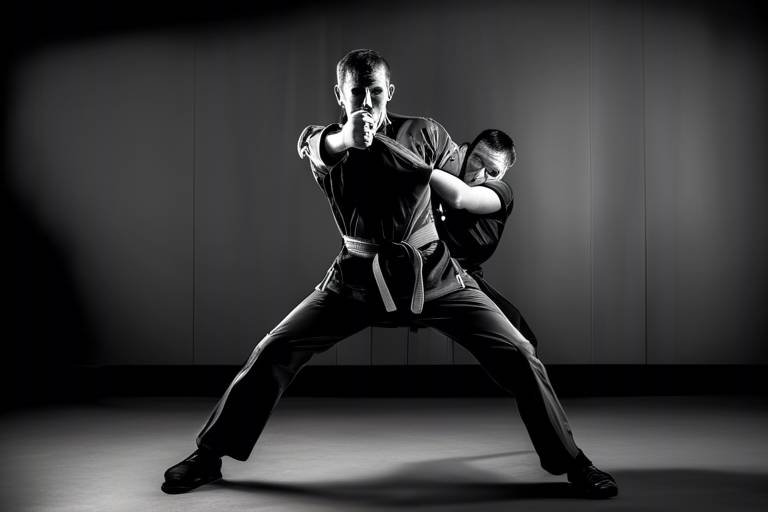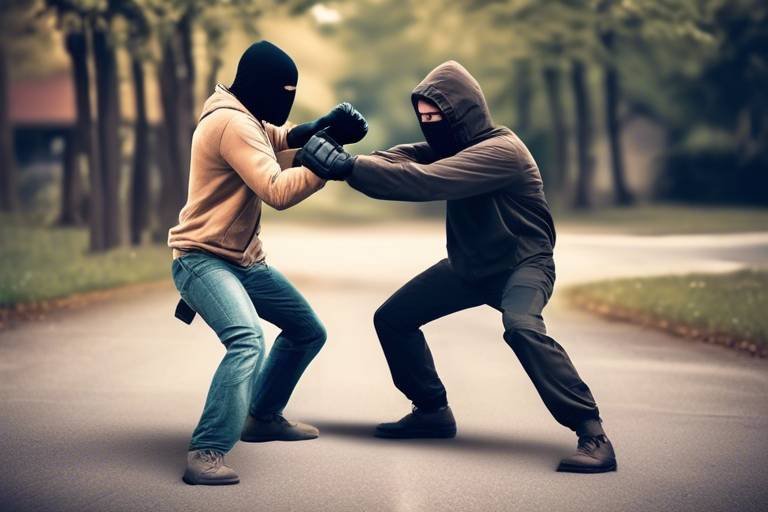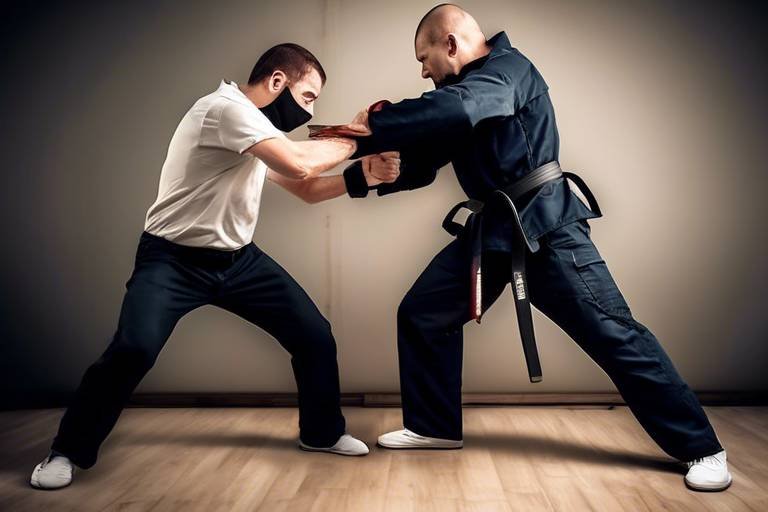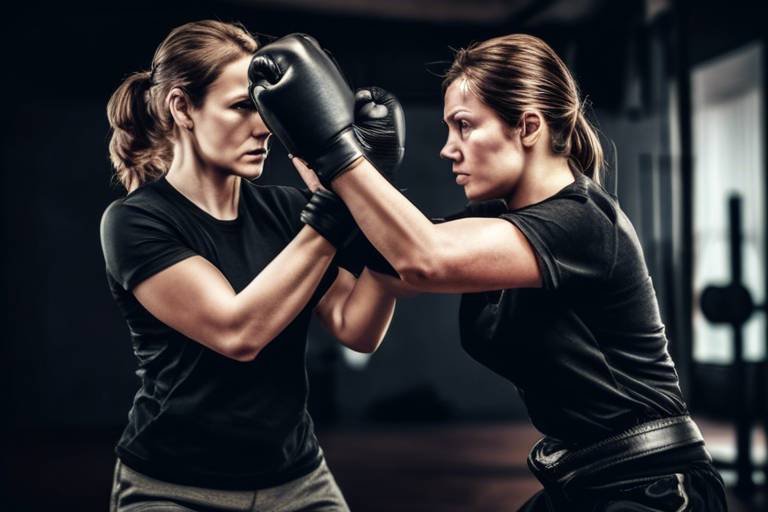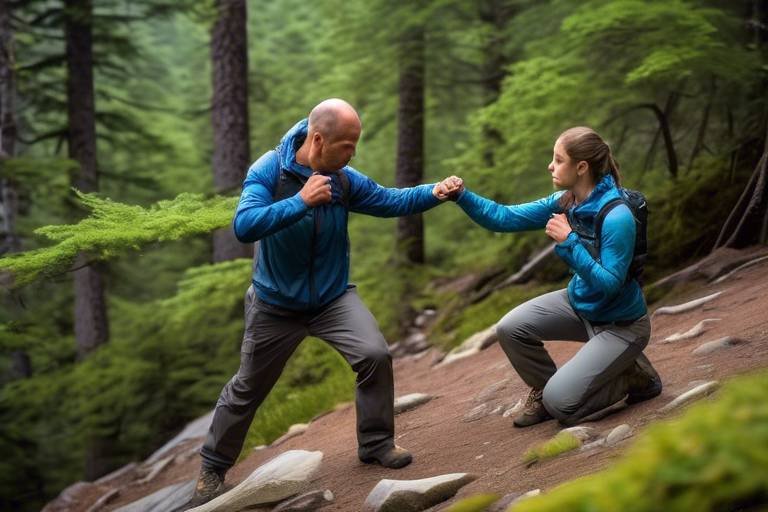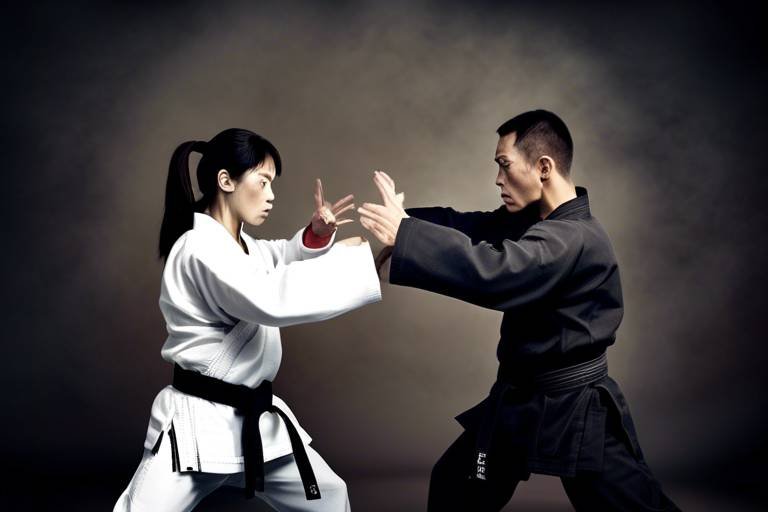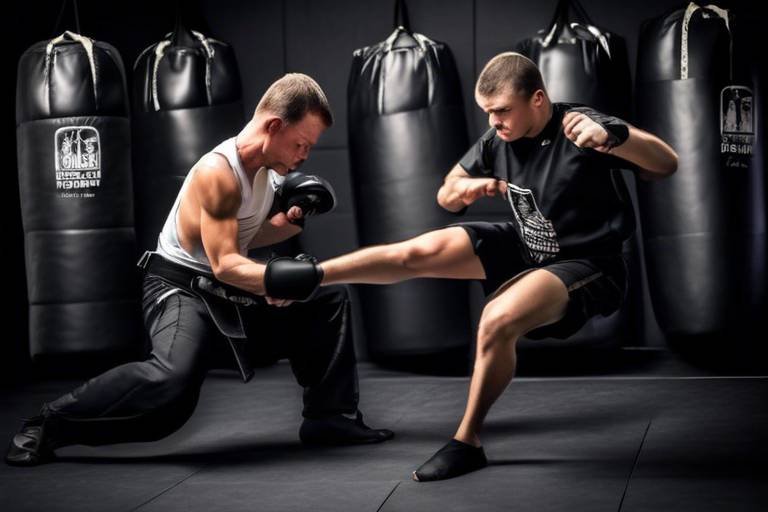How to Implement the Element of Surprise in Self-Defense Techniques?
In today's world, personal safety is paramount, and knowing how to defend oneself can make all the difference during an unexpected encounter. One of the most effective ways to enhance your self-defense skills is by incorporating the element of surprise. Imagine being in a situation where an attacker approaches you with the intent to harm. What if you could turn the tables and catch them off guard? This article explores various strategies and techniques for implementing surprise in self-defense, ultimately enhancing your effectiveness in unexpected situations while ensuring your personal safety and building confidence.
The element of surprise is not just about physical techniques; it’s also about mindset and preparation. When you surprise an attacker, you disrupt their expectations and create an opportunity to escape or counterattack. Think of it like a magician performing a trick; the audience is so focused on what they think will happen that they completely miss the real action. In self-defense, your goal is to be the magician, using deception and unexpected movements to keep your attacker off balance.
One of the first steps in implementing surprise is understanding the psychology behind it. When we experience surprise, our brains go through a series of rapid changes. The suddenness can cause an attacker to hesitate, giving you a crucial moment to react. As a defender, you can use this to your advantage by training yourself to remain calm and composed, even in high-stress situations. This mental preparation, combined with physical techniques, can significantly enhance your self-defense capabilities.
To effectively implement surprise, you can employ various techniques. These include feints, sudden movements, and creating a unique approach to your self-defense strategy. Each of these methods serves to catch your attacker off guard, allowing you to gain the upper hand. For instance, feints can mislead an attacker into thinking you are going to strike in one direction, only to quickly change your movement and hit them from another angle. This unpredictability can be your greatest ally.
Additionally, understanding your environment plays a crucial role in executing surprise techniques. Whether it’s using nearby objects for protection or finding an escape route, being aware of your surroundings can provide you with numerous opportunities to implement surprise effectively. The key is to stay alert and adaptable, ready to use whatever is at your disposal.
In conclusion, the element of surprise is a powerful tool in self-defense. By understanding the psychology of surprise, employing various techniques, and being aware of your surroundings, you can enhance your self-defense skills significantly. Remember, the goal is not just to fight back but to create an opportunity for escape and safety. So, train your mind and body to be unpredictable, and you'll find that you can turn the tide in your favor when it matters most.
- What is the best way to practice surprise techniques?
Regular training with a partner, focusing on scenario-based drills, can help you practice these techniques effectively. - Can I use surprise techniques in real-life situations?
Yes, but it's essential to remain aware of your surroundings and assess the situation before acting. - How can I improve my reaction time for surprise techniques?
Incorporating reaction drills and agility exercises into your training routine can significantly enhance your reflexes. - Are there specific self-defense classes that focus on surprise techniques?
Many martial arts and self-defense classes incorporate elements of surprise, so look for those that emphasize situational awareness and unpredictability.

The Psychology of Surprise
Understanding the psychological impact of surprise can significantly enhance self-defense techniques. When we think about self-defense, we often focus on physical skills and techniques, but the mind plays a crucial role in how these skills are executed. The element of surprise can tilt the odds in your favor, affecting not only your reactions but also those of your attacker. Have you ever noticed how a sudden loud noise can make you jump? That instinctive reaction is a fundamental part of human psychology, and it can be harnessed in self-defense situations.
Surprise can create a momentary lapse in judgment for an attacker. When someone is caught off guard, their decision-making process can become clouded, leading to hesitation or confusion. This is the perfect opportunity for a defender to act. Imagine being in a situation where an attacker approaches you with a clear intention. If you suddenly change your stance, make an unexpected movement, or execute a feint, you may disrupt their focus and gain a critical advantage. The psychological shift from aggressor to confused bystander can be profound.
Moreover, surprise can trigger a fight-or-flight response. This physiological reaction can either empower you to act decisively or leave your attacker paralyzed by fear. It's fascinating how the brain processes surprise; it can heighten awareness and sharpen reflexes. In essence, when you introduce the element of surprise, you not only protect yourself but also manipulate the psychological state of your opponent. This dual-layered approach makes self-defense not just a physical battle but a mental one as well.
To illustrate the psychology of surprise, consider the following table that summarizes how surprise affects both the defender and the attacker:
| Aspect | Defender | Attacker |
|---|---|---|
| Awareness | Heightened senses, increased focus | Disoriented, less aware |
| Decision-Making | Quick, instinctive reactions | Hesitation, confusion |
| Emotional Response | Confidence boost | Fear or uncertainty |
| Physical Response | Increased adrenaline, readiness to act | Possible paralysis or retreat |
In conclusion, the psychology of surprise in self-defense is a fascinating interplay between mind and body. By understanding how surprise affects both you and your attacker, you can develop strategies that not only rely on physical prowess but also on psychological tactics. Remember, the next time you find yourself in an uncomfortable situation, a well-timed surprise can be your best weapon.
Stay tuned for our Frequently Asked Questions section at the end of this article, where we will address common queries regarding the use of surprise in self-defense techniques!

When it comes to self-defense, the element of surprise can be your greatest ally. Imagine being in a tense situation where your heart races, and your mind is flooded with adrenaline. In those moments, employing surprise techniques can turn the tide in your favor. But what exactly are these techniques? They can range from simple distractions to more complex maneuvers that catch an attacker off guard. Let's dive deeper into the various methods you can use to surprise an assailant and enhance your self-defense skills.
One of the most effective ways to leverage surprise is through feints and deception. This involves tricking your opponent into thinking you are going to perform one action while actually preparing to execute another. For instance, you might feign a strike to the left, only to quickly redirect your movement to the right. This not only confuses the attacker but also creates an opening for a real attack or escape. The psychological impact of feints can be profound, as they disrupt the attacker's focus and decision-making process.
Another powerful technique is employing sudden movements. Think of a startled deer darting away at the first sign of danger; that’s the kind of unpredictability you want to emulate. Sudden shifts in your position can disorient an attacker, making it difficult for them to anticipate your next move. For example, if you are cornered, a quick pivot or a drop to the ground can create a chance for you to evade or counterattack. The key here is to remain unpredictable and fluid in your movements.
Moreover, the uniqueness of your approach can significantly enhance the surprise element. Personalizing your self-defense techniques means that they become less predictable to potential attackers. This might involve integrating elements from different martial arts or even creating your own signature moves. When you train in a way that reflects your personality and strengths, you not only boost your confidence but also keep your opponents guessing.
Lastly, let’s not overlook the importance of environmental awareness. Your surroundings can serve as a formidable ally in a self-defense situation. Whether it's a crowded street, a dimly lit alley, or even a park, being aware of your environment allows you to use it to your advantage. For instance, if you notice a nearby object that can be used as a barrier or a distraction, you can incorporate that into your strategy. The element of surprise can also stem from using the environment to create unexpected opportunities for escape or counterattack.
In conclusion, the types of surprise techniques in self-defense are not just about physical moves; they encompass psychological tactics, environmental awareness, and personal creativity. By mastering these techniques, you not only enhance your self-defense skills but also build the confidence needed to face unexpected situations head-on. Remember, it’s not just about knowing how to defend yourself; it’s about being able to surprise your attacker and turn the tables in your favor.
- What are feints in self-defense? Feints are deceptive movements designed to mislead an attacker into anticipating one action while you execute another.
- How can I improve my sudden movements? Practicing drills that focus on agility and quick directional changes can help enhance your ability to move unexpectedly.
- Why is environmental awareness important? Being aware of your surroundings allows you to utilize objects and obstacles to your advantage, making it easier to surprise an opponent.

When it comes to self-defense, feints and deception are like the secret spices in a chef's recipe; they can completely transform the outcome of a confrontation. Imagine being in a situation where an attacker is approaching you with a menacing look. Instead of panicking, you can use feints to mislead and confuse them. Feints are not just about throwing a punch or a kick; they involve creating the illusion of an attack, only to pivot and strike in a different direction. This tactic can leave your opponent vulnerable and off-balance, giving you the upper hand.
To effectively employ feints, you need to understand the psychology behind them. When you feint, you are not only deceiving your attacker but also forcing them to react. This reaction often reveals their intentions and vulnerabilities. For instance, if you feint a jab to the face, your opponent may instinctively raise their guard, exposing their midsection. This is your cue to strike where they are least prepared. It’s all about reading your opponent and adapting your strategy in real-time.
Here are some key points to consider when using feints in self-defense:
- Timing is Everything: The effectiveness of a feint depends largely on the timing of your movement. A well-timed feint can create a split-second opportunity for you to counterattack.
- Body Language: Use your body language to convey a false intention. Leaning forward, shifting your weight, or even making eye contact can signal an impending attack, leading your opponent to react prematurely.
- Practice Makes Perfect: Like any skill, feinting requires practice. Regular drills can help you become more fluid and convincing in your movements.
Moreover, deception in self-defense is not limited to physical movements. Verbal cues can also play a significant role. A simple shout or distraction can momentarily confuse your attacker, giving you a chance to escape or counter. Think of it like a magician's trick; the more convincing the deception, the more effective it becomes.
Incorporating feints and deception into your self-defense repertoire not only enhances your effectiveness but also boosts your confidence. When you know how to mislead an attacker, you are not just reacting to a threat; you are taking control of the situation. Remember, the goal of self-defense is not just to defend yourself but to create an opportunity to escape unharmed.
In summary, mastering the art of feints and deception can be a game-changer in self-defense scenarios. By understanding your opponent's psychology and employing strategic movements, you can turn the tables and ensure your safety. So, the next time you find yourself in a precarious situation, remember that a little creativity can go a long way in keeping you safe.
Q: How can I practice feints effectively?
A: You can practice feints by engaging in partner drills where one person feints while the other reacts. This helps in developing timing and understanding how to read an opponent's movements.
Q: Are feints useful in real-life self-defense situations?
A: Yes, feints can be incredibly useful in real-life situations as they create openings and confuse attackers, allowing you to escape or counter-attack effectively.
Q: Can feints be used with any martial arts style?
A: Absolutely! Feints can be adapted to various martial arts styles, whether it’s boxing, karate, or Brazilian jiu-jitsu. The key is to incorporate them into your training.

When it comes to self-defense, one of the most effective strategies is to incorporate sudden movements into your technique. Think of it as a game of chess, where every move you make can determine the outcome. In a self-defense scenario, being unpredictable can be your greatest asset. Imagine you're in a situation where an attacker is approaching you with aggression. Instead of standing your ground, a sudden shift in your position can catch them completely off guard. This isn’t just about physical movement; it’s about creating opportunities and exploiting the moment of surprise.
Sudden movements can manifest in various forms. For instance, you might choose to step aside quickly to avoid an attack or execute a rapid pivot to change your angle of engagement. This can disorient your opponent, making them hesitate or miscalculate their next move. The beauty of sudden movements lies in their ability to confuse and disrupt an attacker's rhythm. When they expect you to move in one direction, a swift change can leave them vulnerable.
Consider incorporating specific techniques into your training to master sudden movements. Here are a few examples:
- Side Steps: Quickly moving to the side can help you evade an incoming strike while positioning yourself for a counterattack.
- Back Pedaling: A sudden retreat can lure an attacker into overcommitting, allowing you to strike back effectively.
- Spinning Techniques: A quick spin can create distance and surprise, especially if you follow up with a strike or escape.
To truly harness the power of sudden movements, practice is key. Engaging in drills that emphasize quick changes in direction or unexpected shifts in your stance can dramatically improve your effectiveness in real-world scenarios. This is not just about physical fitness; it's about training your mind to react instinctively. The more you practice, the more natural these movements will become, allowing you to respond to threats with confidence and agility.
Moreover, it's essential to maintain a level of awareness during these movements. Being mindful of your surroundings can help you identify potential escape routes or advantageous positions. For instance, if you’re near a wall, a sudden movement towards it could give you leverage to push off and create distance. Remember, the goal is not to engage unnecessarily but to create an opening for escape or a counterattack.
In conclusion, mastering sudden movements in self-defense is about more than just physical agility; it’s about developing a mindset that embraces unpredictability. By training your body and mind to react swiftly and unexpectedly, you can turn the tables on an attacker, transforming a potentially dangerous situation into one where you regain control. So, the next time you think about self-defense, remember: sometimes, the most powerful weapon you have is your ability to move in ways that catch your opponent completely off guard.
Q1: How can I practice sudden movements effectively?
A1: Incorporate drills that focus on lateral movements, pivots, and unpredictable shifts in your training routine. Partner drills can also simulate real-life scenarios for better practice.
Q2: Are sudden movements suitable for everyone?
A2: Yes, while the execution may vary based on physical ability, anyone can learn to incorporate sudden movements into their self-defense technique with proper training.
Q3: What should I focus on while executing sudden movements?
A3: Focus on maintaining balance, staying aware of your surroundings, and being ready to follow up with a counterattack or escape.

When it comes to self-defense, the element of surprise is not just about quick reflexes or powerful strikes; it’s also about personalization. Everyone has a unique style, background, and physicality, which means that your approach to self-defense should reflect who you are. Think of it like cooking—while there are classic recipes, the best chefs add their own twist to make a dish truly special. Similarly, by incorporating your own flair into self-defense techniques, you not only enhance your effectiveness but also keep potential attackers guessing.
Imagine you’re in a situation where an assailant approaches you. If you’ve trained with a cookie-cutter technique, your movements may be predictable. However, if you’ve tailored your approach—maybe you’ve combined elements of martial arts you’ve learned with street smarts or even dance moves—you’ll create a fluidity that’s hard to anticipate. This unpredictability can be your greatest ally. Not only does it keep you safer, but it also boosts your confidence. When you believe in your unique method, you’re less likely to freeze in a moment of panic.
To develop this unique approach, consider the following strategies:
- Assess Your Strengths: What are you naturally good at? Whether it’s agility, strength, or even your ability to read people, leverage these traits.
- Experiment: Don’t be afraid to try different techniques and see what feels right. The more you practice, the more you’ll find what works best for you.
- Incorporate Your Interests: If you have a background in dance, yoga, or even a sport, think about how those movements can be integrated into your self-defense strategy.
Moreover, the uniqueness of your approach doesn’t just stop at technique. It can also involve your mental state and attitude. Being aware of your surroundings, staying calm under pressure, and having a mindset geared towards creativity can all play significant roles in how effectively you can surprise an attacker. When faced with danger, your instinct might be to fight or flee, but a unique approach allows for a third option: innovate. This innovation can manifest in unexpected maneuvers or strategies that leave an assailant bewildered.
In conclusion, embracing the uniqueness of your approach in self-defense not only enhances your ability to surprise an attacker but also empowers you. Remember, the best defense is not just about physical techniques but also about how you carry yourself and adapt to any situation. So, take the time to discover what makes your self-defense style uniquely yours, and use that to your advantage.

When it comes to self-defense, the world around you can be your greatest ally or your worst enemy. Environmental awareness is about understanding your surroundings and using them to your advantage. Imagine walking down a street and suddenly feeling threatened; your immediate reaction should be to assess your environment. Are there any objects nearby that can be used as a shield or a weapon? Is there a crowd you can blend into? By being aware of your surroundings, you can utilize them effectively to enhance your self-defense techniques.
Consider this: the environment is not just a backdrop; it’s a dynamic part of your self-defense strategy. For instance, if you're in a narrow alley, your options for movement may be limited, but you can use the walls to your advantage. A quick sidestep could put your attacker off balance, giving you the opportunity to escape or counterattack. On the other hand, an open space allows for more evasive maneuvers, but you must be cautious of potential escape routes and obstacles.
Here are some key aspects to consider when developing your environmental awareness:
- Spatial Awareness: Always be conscious of the distance between you and potential threats. This awareness can dictate your reaction time and available options.
- Potential Weapons: Look for items in your environment that can serve as improvised weapons. This could be anything from a stick to a backpack, depending on the situation.
- Escape Routes: Identify exits and potential escape routes before a confrontation occurs. This foresight can save precious seconds when you need to act quickly.
- Lighting and Visibility: Consider how lighting affects your ability to see and be seen. Well-lit areas can offer safety, while poorly lit places can provide cover for an attacker.
Moreover, practicing self-defense techniques in different environments can prepare you for various situations. Whether it’s a crowded subway station, a park, or a dimly lit street, each setting presents unique challenges and opportunities. By simulating these environments during training, you can develop a keen sense of how to react in real-life scenarios. This practice will not only enhance your physical skills but also build your confidence in navigating unexpected situations.
In summary, environmental awareness is a crucial component of effective self-defense. By understanding and utilizing your surroundings, you can significantly increase your chances of successfully defending yourself. Always remember, the more aware you are, the better prepared you will be to respond to threats. So next time you step out, take a moment to observe your environment; it could make all the difference in a critical situation.
- What is environmental awareness in self-defense? Environmental awareness involves understanding and utilizing your surroundings to enhance your self-defense strategies.
- How can I improve my environmental awareness? Regularly practice being mindful of your surroundings, identify potential escape routes, and look for objects that can be used in self-defense.
- Why is environmental awareness important? It helps you react more effectively in threatening situations, allowing you to use your environment to your advantage.

When it comes to self-defense, the element of surprise can be a game changer. It’s not just about knowing how to throw a punch or execute a kick; it’s about being ready to react in ways that your attacker doesn’t expect. Training specifically for surprise scenarios can significantly improve your self-defense readiness. Imagine walking down the street and suddenly finding yourself in a potentially dangerous situation. Your ability to respond swiftly and unexpectedly could mean the difference between escaping unharmed or facing a confrontation head-on. So, how do you prepare for these unpredictable moments?
First off, engaging in scenario-based training is crucial. This type of training allows practitioners to practice surprise techniques in realistic contexts. Think of it as a dress rehearsal for a play; you wouldn’t just read the script, right? You’d want to act it out, feel the emotions, and get into character. In self-defense, this means simulating real-life situations where you might need to react quickly. For instance, you could set up a training session where a partner unexpectedly approaches you from behind. The goal is to practice your reaction in a safe environment, refining your ability to respond with surprise.
Moreover, incorporating reaction drills into your training regimen is essential. These drills focus on developing quick responses, enhancing your reflexes, and improving your ability to surprise an opponent during an altercation. Picture this: you’re in a controlled environment, and your trainer suddenly throws a soft object at you from an unpredictable angle. Your task is to react instinctively, whether that means dodging, blocking, or countering. This kind of practice not only sharpens your reflexes but also builds your confidence in handling unexpected situations.
Another effective method is to incorporate dynamic movement exercises. These exercises can help you become more agile and unpredictable in your movements. For example, practicing lateral shuffles, sudden pivots, or even jumping can make you less predictable to an attacker. When you’re fluid and spontaneous in your movements, you create openings for surprise attacks or escapes. It’s like dancing; the more you practice, the more instinctive your movements become, allowing you to flow seamlessly from one action to another.
Lastly, it’s important to remember that the element of surprise isn’t just about physical techniques; it also involves mental preparation. Visualization techniques can be incredibly beneficial. Spend some time imagining various scenarios where you might need to defend yourself. Visualize how you would react, what techniques you would use, and how you could leverage the element of surprise. This mental rehearsal can enhance your readiness and confidence, making you feel more equipped to handle real-life situations.
- What is the best way to practice surprise in self-defense? Engaging in scenario-based training and reaction drills are effective methods to practice surprise techniques.
- Can mental preparation really help in self-defense? Yes, visualization techniques can significantly enhance your readiness and confidence in handling unexpected situations.
- How often should I train for surprise techniques? Consistent practice is key. Aim for at least a few sessions a week to build your skills and reflexes.

When it comes to self-defense, having the right techniques is only half the battle; the other half lies in how you apply those techniques in real-world situations. Scenario-based training is a game changer in this regard, allowing practitioners to immerse themselves in realistic encounters where the element of surprise can be practiced and perfected. Imagine walking into a training session where the scenarios are designed to mimic potential threats you might face in everyday life. This method not only boosts your confidence but also sharpens your instinctual reactions.
In scenario-based training, the focus is on creating a dynamic environment where you can practice your skills against a live opponent or in a controlled setting. This allows you to experience the adrenaline rush and unpredictability of a real encounter. For example, you might practice defending against an attacker who suddenly approaches you from behind, or you could simulate a situation where you need to escape from a confined space. The key here is to replicate the surprise element, as it can significantly influence the outcome of a confrontation.
To make the most of scenario-based training, consider incorporating various elements:
- Realistic Scenarios: Craft scenarios that reflect potential threats in your daily life. This could include situations like being approached in a parking lot or dealing with an aggressive individual in a public space.
- Variable Outcomes: Allow for different outcomes in each scenario. Sometimes, you might successfully escape, while other times, you might need to fight back. This variability helps you adapt and think on your feet.
- Feedback and Reflection: After each scenario, take time to reflect on what worked and what didn’t. This feedback loop is crucial for improvement.
Additionally, partnering with a training buddy or a coach can enhance your experience. They can play the role of the attacker, which not only adds realism but also helps you practice your surprise techniques against a live opponent. Think of it as a dance; you need to know your partner's moves to anticipate and counter effectively. Training in this way can be exhilarating and eye-opening, revealing your strengths and areas for improvement.
Moreover, scenario-based training is not just about physical techniques; it also emphasizes mental preparedness. You will learn to assess situations quickly, identify escape routes, and make split-second decisions that can mean the difference between safety and danger. This mental agility complements your physical skills, making you a more formidable defender. By regularly engaging in these training sessions, you can build a repertoire of responses that are instinctual and effective. So, are you ready to step into the training ring and surprise yourself?
Q: How often should I engage in scenario-based training?
A: Ideally, you should incorporate scenario-based training into your routine at least once a week. Regular practice helps reinforce your skills and keeps your reactions sharp.
Q: Can I practice scenario-based training alone?
A: While practicing with a partner is highly beneficial, you can also simulate scenarios alone by visualizing potential threats and mentally rehearsing your responses.
Q: What if I feel overwhelmed during a scenario?
A: It's normal to feel overwhelmed at first. Start with simpler scenarios and gradually increase the complexity as you build confidence and skill.
Q: How can I make my training more realistic?
A: Incorporate elements such as different environments, varying levels of aggression from your partner, and unexpected distractions to mimic real-life unpredictability.

When it comes to self-defense, the ability to react swiftly can be the difference between safety and danger. Reaction drills are designed to enhance your reflexes and ensure that your body responds instinctively in high-pressure situations. Imagine being in a scenario where every second counts; your ability to react can turn the tide in your favor. These drills not only improve your physical responses but also boost your confidence, making you feel more prepared to handle unexpected encounters.
One effective way to implement reaction drills is through partner exercises. Pair up with someone and take turns initiating actions. For example, one partner can feint an attack while the other practices their defensive maneuvers. This not only sharpens your reflexes but also helps you learn to read your opponent’s body language. The more you practice, the more you’ll understand how to anticipate movements, which is crucial in a real-life situation. Think of it like a dance; the better you know your partner's steps, the smoother the performance.
Another engaging method is to use reaction balls. These are small, unpredictable balls that bounce in various directions. By reacting to the ball's movement, you can train your hand-eye coordination and improve your ability to respond quickly to sudden changes in your environment. This drill can be done alone or with a partner, making it versatile for any training session. You might even consider incorporating it into your warm-up routine, adding an element of fun while honing your skills.
For those who enjoy technology, consider using apps or virtual reality (VR) systems designed for self-defense training. These platforms often simulate real-life scenarios where you must react to various threats. They provide instant feedback, allowing you to analyze your performance and make adjustments. This tech-savvy approach can be both engaging and educational, making the learning process enjoyable.
Incorporating a variety of drills into your routine is essential. Here are a few types of reaction drills you might want to consider:
- Shadow fighting: Practice your techniques against an imaginary opponent, focusing on speed and precision.
- Obstacle courses: Set up a course that requires you to navigate while reacting to various stimuli, such as sounds or visual cues.
- Timed drills: Challenge yourself to complete a series of self-defense techniques within a specific time frame, pushing your limits and enhancing your speed.
Ultimately, the goal of reaction drills is to create muscle memory so that your body knows how to respond without having to think about it. Just like a well-rehearsed play, the more you practice, the more natural it becomes. So, get out there, start drilling, and embrace the element of surprise in your self-defense strategy!
Q: How often should I practice reaction drills?
A: It's recommended to practice reaction drills at least 2-3 times a week to see significant improvements in your reflexes and confidence.
Q: Can I do reaction drills alone?
A: Yes, many drills can be performed solo, such as using a reaction ball or shadow fighting. However, incorporating a partner can enhance the experience.
Q: Are reaction drills suitable for beginners?
A: Absolutely! Reaction drills can be adjusted to fit any skill level, making them a great addition to any training regimen.
Frequently Asked Questions
- What is the element of surprise in self-defense?
The element of surprise in self-defense refers to using unexpected tactics or actions to catch an attacker off guard. By creating an unpredictable response, a defender can gain the upper hand, making it harder for the attacker to react effectively.
- How does surprise affect the psychology of an attacker?
Surprise can significantly disrupt an attacker's thought process. When faced with an unexpected move or tactic, an attacker may hesitate or become confused, giving the defender a crucial moment to escape or counterattack. It's like throwing a curveball in a baseball game—sudden changes can throw off the best players!
- What are some effective surprise techniques in self-defense?
Some effective surprise techniques include feints, sudden movements, and unexpected strikes. By misdirecting an attacker or changing positions suddenly, you can create openings that allow for a quick escape or a powerful counterattack.
- How can I train to enhance my surprise tactics?
Training for surprise can involve scenario-based drills that mimic real-life situations. Practicing reaction drills can also improve your ability to respond quickly and effectively when faced with an unexpected threat.
- Why is environmental awareness important in self-defense?
Being aware of your surroundings can significantly enhance your ability to implement surprise. Using objects or features in your environment—like walls or furniture—can create opportunities to distract or disorient your attacker, making your response more effective.
- Can I personalize my self-defense techniques?
Absolutely! Personalizing your self-defense techniques can make them less predictable. By incorporating your unique movements and styles, you can surprise potential attackers, making it harder for them to anticipate your actions.
- What role do reaction drills play in self-defense training?
Reaction drills are crucial for developing quick reflexes and responses. They help you practice surprising an opponent in various scenarios, ensuring that when the moment arises, you can act swiftly and effectively.
- How can I create realistic training scenarios?
To create effective training scenarios, simulate real-life situations that you might encounter. Incorporate various elements like different environments, potential attackers, and unexpected challenges to prepare yourself for the unpredictability of real encounters.

